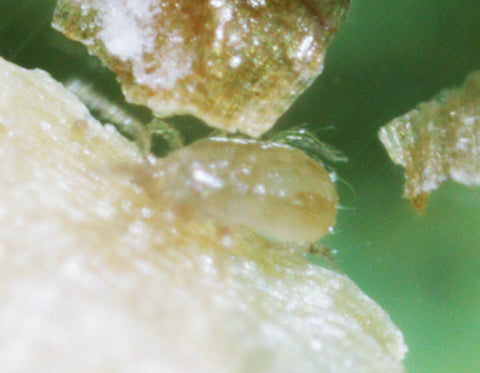Spider Mite Control
About Spider Mites
There are over 1,200 species of spider mites in the world. However, the Two-Spotted Spider Mite is the most common. Two-Spotted Spider Mites are easily identified by the two "spots" on their back. These mites feed on the underside of leaves causing stippling damage. In addition, spider mite activity is visible in the tight webs that are formed under leaves and along stems. Spider mites thrive in high heat and low humidity.
Spider Mite Control with Predatory Mites
Predatory mites provide a natural and organic way to control an infestation of spider mites in your garden, greenhouse, or grow room. They feed on all life stages of unwanted pests and help to balance the ecosystem.
Bottles vs Sachets
PREDATORY MITES IN BOTTLES:
Best choice for an active infestation.
Our adult predatory mites are a natural tool to help cure an active infestation of mites.Our beneficial insects work quickly to reduce light to moderate infestations. With heavier infestations, increase in quantity and frequency may be required.
SLOW RELEASE SACHETS:
Don't fight pests, prevent them.
Avoiding garden pests is far easier than dealing with an outbreak of bad bugs - be proactive by preventing the problem. Our sachets are filled with predatory mites in a variety of life stages, providing a slow release of pest control into your garden. When it comes to having a healthy garden, preventative care is key.
Predatory Mite Species
There are many species of predatory mites used for pest control:

Target Pest: Two-Spotted Spider Mites.
Description: Adults are tiny (.3 mm long), fast moving, red, pear-shaped mites with noticeably long legs. Unlike its natural enemy, the Two-Spotted Spider Mite, P. persimilis does not spin webbing.

Target Pest: Broad Mites, Cyclamen Mites, Russet Hemp Mites, and Two-Spotted Spider Mites.
Description: A generalist feeder, the color of A. andersoni is completely dependent on what they are feeding on. They are best known for their ability to survive high temperatures, but will survive over the winter as well.

Target Pest: Two-Spotted Spider Mites, Broad Mites, Cyclamen Mites, Russet Mites, and Rust Mites.
Description: Californicus is pear-shaped and tan in color. They have a slower paced eating habit, which allows them to survive longer with limited food supply. Works great for preventative control.

Target Pest: Broad Mites, Russet Hemp Mites, Thrips, Whiteflies, Tarsonemid Mites, and many other mite species.
Description: Amblyseius swirskii can be used indoors and outdoors on a wide range of host plants. They can treat many types of spider mites, thrips, and whitefly larvae.

Target Pest: Thrips, Cyclamen Mites, Broad Mites, Rust Mites, and many other mite species.
Description: Amblyseius cucumeris is a species of predatory mite that feeds on immature stages of thrips. It also feeds on pollen, Two-Spotted Spider Mites, and many other mite species.
Target Pest: Broad Mites, Red Mites, Pacific Mites, Spider Mites, Two-Spotted Spider Mite, and many other mite species.
Description: This predatory mite has a strong preference for pest mite species and will gravel from tree to tree searching for them.
SPECIAL BLEND SPIDER MITE CONTROL:

Target Pest: Two-Spotted Spider Mites, Broad Mites, Rust Mites, Cyclamen Mites, Russet Mites, and many other mite species.
Description: Special Blend Spider Mite Control consists of an assortment of the following predatory mites: A. andersoni, A. cucumeris, P. persimilis, A. swirskii, and N. californicus. Our Special Blend takes the guess work out of which mite should be used in your garden, greenhouse, or grow room.

